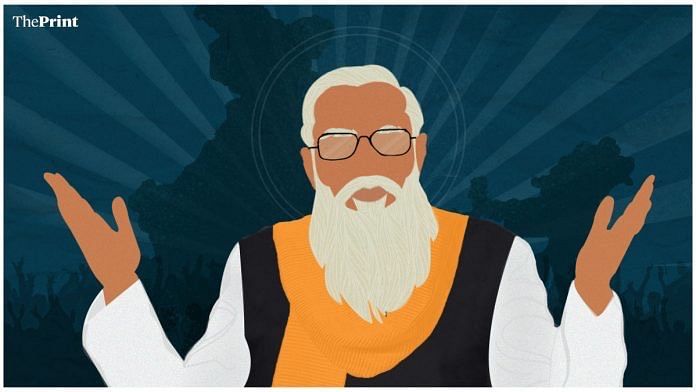In a country where the definition of a bestseller is 10,000 copies, you know that Indians don’t read. You could be sanguine about this and say we are an oral culture. Or you could blame an education system that encourages rote learning and mass production of engineers and MBAs.
The result is that we don’t know what our icons stand for. We only know them through popular culture. Not just our icons, but any icon. Foreigners are alarmed to see copies of Adolf Hitler’s Mein Kampf sold on India’s streets. Many draw a link between that and the growing support for authoritarianism and hate crimes. I don’t worry about people buying Mein Kampf. I am confident that 9 out of 10 people who buy it don’t read it. The book is for the shelves.
What we see here is iconophilia — a fascination with iconography. Much more popular than Mein Kampf is Che Guevara. When businessman Arindam Chaudhuri and Republic TV anchor Arnab Goswami name their children Che, they’re certainly not advocating for revolution in India. More likely, they are just taken in by the cult of Che, the Che T-Shirts people used to wear. Cool guy. Nice hair. Fancy cap.
Also read: Wear Che Guevara, Johnny Walker and Gandhi on your T-shirts, but it says nothing about you
What do our icons stand for?
Visual representations of Rabindranath Tagore and Subhas Chandra Bose are familiar to every Indian. From Ladakh to Leh, Indians are made familiar with them in school. Most of us don’t even know what Tagore stood for, or whether Subhas Chandra Bose was a secularist. Do we realise what would have happened had Bose succeeded in his plans, given who he was allying with? Do we understand that Tagore placed humanism over nationalism, and was in fact so troubled by the negative potential of nationalism that he had differences with Gandhi about it?
Yes, you can hear Rabindrasangeet across Bengal. We are an oral culture. The progressive worldview of Tagore, however, is for the libraries and universities. What is important about Tagore in popular culture is that he was the first Indian to have won a Nobel prize, not what he won the Nobel prize for. How many people do you know who can tell what his collection of poems Gitanjali is about, let alone having read it?
Also read: 10 Ambedkar quotes that show why the BJP can’t co-opt him
In any other country, you’d expect the literary works of a Nobel-winning author to be part of popular culture. Not in India. That’s why Narendra Modi can transform into Tagore. If Indians, other than a few bhadraloks in Kolkata, actually knew what Tagore stood for, Modi would not be able to appropriate him. It would have been as impossible as, say, Modi appropriating Nehru — because, in Nehru’s case, at least his commitment to secularism is part of popular discourse.
The Bharatiya Janata Party’s appropriation of Dalit icon B.R. Ambedkar is, similarly, an act of dealing with iconography over ideas. The Dalit movement does have a culture of actually reading Ambedkar, though the thick volumes of his collected writings are mostly for the shelves. The Ambedkarite movement focuses more on reading about Ambedkar’s life than his message. If the Dalit masses who install Ambedkar’s photos on their walls actually read him, we would have a lot more Buddhists in India!
Nevertheless, thanks to Ambedkar’s emphasis on education, and the revival of his political import since the ‘90s, a lot more people read Ambedkar than, say, Gandhi. Or Maulana Azad. It is a wonder that the BJP hasn’t yet appropriated Azad, given what we know by now of his criticism of the Congress. It’s just that the BJP today doesn’t even need ‘good’ Muslims.
Also read: To save the republic, India must read these books
Need to engage with texts
The Congress and others can also appropriate icons just as easily. Since people only relate to the photo, the clothes, the visage — anyone can appropriate any icon. This is why politicians can subvert the Constitution and still swear by it. Is there a culture of reading, discussing or understanding the Constitution and its import?
Symbols can be hollowed out of meaning, and then imbued with new meaning. In its post-Indira stupor, the Congress party gave up on the joint venture Nehru had forged between nationalism and secularism. This meant the Rashtriya Swayamsevak Sangh (RSS) no longer needed to avoid the Indian flag, or see it as antithetical to the Hindu nationalist project. When the RSS began to salute the Indian national flag, it began the process of imbuing it with its own agenda. Today, Modi has combined nationalism with Hindutva. The reclaiming of the Indian flag in the anti-CAA movement is, thus, of great significance.
What we need is a culture of reading and engaging with texts. A healthy society would have reading clubs where the ideas of great icons would be discussed and understood, in agreement or disagreement.
The author is a contributing editor. Views are personal.
